#appendix n
Text
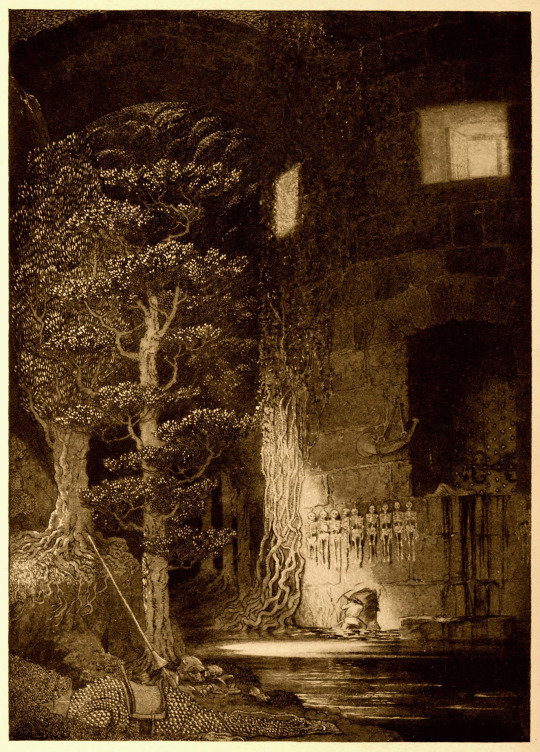
“There the Gibbelins Lived and Discreditably Fed” by Sidney H Sime, from Lord Dunsany’s story “The Hoard of the Gibbelins” in The Book of Wonder, 1912. This is the tale of a knight who becomes obsessed with seeking the treasures of some man-eating creatures who live at the edge of the world. “Alas that I should say of so perilous a venture, undertaken at dead of night by a valorous man, that its motive was sheer avarice!”
The next story in the this collection is “How Nuth Would Have Practised His Art Upon the Gnoles” in which two thieves go into the gnoles’ forest to steal their emeralds.
Lord Dunsany’s most important influence on D&D probably isn’t his vaguely described fairy tale monsters, but his greedy human characters who travel to the homes of nonhuman creatures to steal from them, often coming to a bad end. D&D originally awarded characters 1 experience point per 1 gold piece looted, as well as for defeating monsters, prompting players to follow the examples of Lord Dunsany’s adventurous thieves and seek ever greater riches in more dangerous lairs.
#Lord Dunsany#Sidney H Sime#D&D#Appendix N#Dungeons & Dragons#The Hoard of the Gibbelins#The Book of Wonder#dnd#fantasy#gaming history#Dungeons and Dragons#castle#skeletons#dragon#tower#monster mount#There the Gibbelins Lived and Discreditably Fed#gibbelins
502 notes
·
View notes
Note
What are DnD and Pathfinder if not medieval fantasy? Just curious, I've been (perhaps wrongly) calling them that for ages 😅
The classic Fantasy Tabletop RPG setting is similar to medieval fantasy, sure, but much Weirder. With the capital W intentional. D&D owes as much to the Weird Fiction of the early 20th century as it does to Tolkien, if not more. You won't find a crashed spaceship, multiple species of mind controlling alien horrors or a general vibe of adventuring as a thing to do to make a quick buck or die trying in Middle-Earth, Narnia or Westeros, but you will in the Hyborian Age, Newhon, or Zothique.
This is also why Final Fantasy, which started as a D&D ripoff, added airships and robots pretty early on and they fit right in no problem. That kitchen sink attitude towards fantasy, science fiction and horror tropes is very Weird Fiction, and is a hallmark of D&D and especially Pathfinder to this day.
145 notes
·
View notes
Text

Revenge is a dish best served over and over and over again. This week on the Vintage RPG Podcast, we’re talking about Roger Zelazny’s 1971 novel Jack of Shadows. Gygax included the novel — a high-concept blend of fantasy and science fiction — in Appendix N, but it isn’t one that gets talked about all that often. Perhaps because it is such an unrelentingly ugly book, featuring a protagonist who embraces his dark side and never lets go, to the sorrow of everyone around him, and even unto the end of the world as he knows it. This one is DARK. And yet, because it is Zelazny, still incredibly readable and entertaining. That dude could write.
#tabletop rpg#roleplaying game#dungeons & dragons#rpg#d&d#ttrpg#podcast#roger zelazny#Jack of Shadows#Appendix N
28 notes
·
View notes
Text
Read-list for an "old school D&D" fantasy (plus bonus)
This is a remake of an earlier post of mine, that I decided to update (some additional books were suggested to me, others I found out about later).
This is a reading-list of various literary works that heavily inspired or were heavily used in the creation of the first editons of Dungeons and Dragons - and thus, reading them will allow you to plunge back into what the original D&D was meant to look what/what it tried to emulate.
J.R.R. Tolkien's "The Lord of the Rings" and "The Hobbit". No surprise here, Tolkien's works were the start of modern fantasy and thus the main source of old-school D&D. In fact, D&D was originally created to be just a Lord of the Rings role-playing game - or to be precise a LotR wargame. This was the original intention. Which is why, quite famously, the very first version of D&D included elements such as the hobbits, the mithril and the balrogs. And when the Tolkien Estate pointed out the consequences of what was plagiarism, D&D changed these concepts to... "halflings", "mithral" and "balors". The only Tolkien-element D&D could preserve vaguely unchanged were the orcs, because the Tolkien Estate could not prove Tolkien had invented the term "orc". But even beyond that, D&D's dwarfs and elves and ents (sorry, treants) and wights and rangers all were heavily inspired by Tolkien - the gods of the orcs even use symbols such as an "eye of fire" and a "white hand"...
Poul Anderson's "Three Hearts and Three Lions". Poul Anderson was quite influential on early 20th century fantasy, and this specific book influenced D&D in three ways. On one side, it was one of the two sources for the "Order versus Chaos" conflict of D&D (the other being Moorcock). On the other the D&D trolls were inspired by the Three Hearts and Three Lion trolls. And finally the Paladin class was inspired by Anderson's Holger Carlsen character (the same way the Ranger was Tolkien's Aragorn). [This book also seems to have had some influence over the Fey of D&D?]
Michael Moorcock's "The Elric Saga". With Anderson's work, it was the other main source of the Order vs Chaos, Lawful vs Chaotic division of the D&D game. It also served as the main inspiration behind the D&D Drows, due to the Elric Saga shaping the original image of "Dark Elves" in fantasy, through its Melnibonéan Empire. D&D also originally collected references to the Elric world - creating many variation of Elric's evil magical sword Stormbringer through a variety of cursed soul-drinking weapons.
Robert E. Howard's "Conan the Barbarian". The source of heroic-fantasy the same way Lord of the Rings influenced epic fantasy, the world of Conan was also a huge source of inspiration for D&D - the most obvious reference being the Barbarian class, shaped for those who wanted to play Conan.
Fritz Leiber's "Fafhrd and the Gray Mouser". Originally intended as a parody of the Conan-style heroic fantasy, but promptly becoming a serious and admired work that created its own sub-genre of fantasy (the "sword and sorcery" genre), they also were inspirational for the first editions of D&D. Sometimes it is indirect - the "Thief" or "Rogue" classes were inspired by Leiber's Gray Mouser character - other times it is MUCH more direct. For example, among the numerous pantheons you could choose to use in early D&D, one was the various gods of Newhon and the city of Lankhmar, the universe of Fafhrd and the Gray Mouser. And the fantasy trope of "Thieves' Guild" made famous partially by D&D was originally an invention of Leiber.
Jack Vance's The Dying Earth. This emblematic series of the "science-fantasy" genre offered to D&D its magic system, which is generally known as "vancian magic". It was Jack Vance who had the idea that a wizard had to learn/store spells in their mind, with a limited number of spells they could carry in their brain, and that once cast the spell had to be re-learned or restored. Several spells and items of early D&D were also directly taken from the Dying Earth books - the "prismatic spray" or the "ioun stones".
H.P. Lovecraft's "Cthulhu Mythos". No need to explain how Lovecraft's brand of eldritch horror and alien-fantasy shaped the creatures and deities of early D&D, to the point that early on the deities and monsters of the Cthulhu Mythos were part of the pantheons you could chose to use - listed alongside the Newhon gods of Leiber, or the gods of the Conan universe.
While not fantasy works, the most famous creations of Edgard Rice Burroughs - Tarzan on one hand, and John Carter of Mars on the other, were claImed by Gygax to have been very influential to his creation of D&D.
Another author Gygax mentionned as being a huge influence for D&D was Fletcher Pratt - through his Harold Shea fantasy series, about a main character being carried away in various magical and fantastical worlds very different from each other, in which he has to adapt himself to new settings and learn new rules to avoid dangers and threats... Sounds familiar? The idea of world-travelling might also have been inspired by the science-fiction series by P.J. Farmers' World of Tiers: the rules of travel in D&D between the various planes of reality seem to have been inspired by Farmers' own rules for dimension-travel.
One of the lesser known influences of D&D is the fantasy series "Kothar" by Gardner Fox: Gygax explicitely said that the idea of the "Lich" as a D&D monster came from Fox's Kothar series.
Not a book, but movies: the Sinbad movies of the mid 20th century were influential on early D&D. Various monsters and creatures referenced pictures such as "The 7th Voyage of Sinbad" or "The Golden Voyage of Sinbad".
"The House on the Borderlands" by William Hope Hodgson was explicitely referenced by Gygax's 1979 module "The Keep on the Borderlands", and it might have heavily influenced the original depiction of the D&D orcs as pig-men...
The Shannara series by Terry Brooks has also been pointed out as an influence on D&D - while not on the very first edition, elements of the Shannara world seem to have influenced later ones...
Mind you, this is but a fragment of a much longer list known as the "Appendix N" composed by Gygax, and that lists all the books and pieces of work he took inspiration from when designing D&D. Beyond the most famous works evoked above he also listed:
Poul Anderson's "The High Crusade" and "The Broken Sword"
John Bellairs' "The Face in the Frost"
Leigh Brackett's works
Fredric Browns' works
I evoked before Burrough's Mars series, but Gygax also listed his "Venus series" and his "Pellucidar series".
Lin Carter's "World End" series
L. Sprague de Camp's "Lest Darkness Fall" and "The Fallible Fiend" and "The Carnelian Cube"
August Derleth's continuation of the Cthulhu Mythos.
Lord Dunsany's writings, of course.
Gardner Fox's "Kyrik" series
Sterling Lanier's "Hiero's Journey"
A. Merritt's "Creep, Shadow, Creep", "Moon Pool" and "Dwellers in the Mirage"
Michael Moorcock's "Hawkmoon" series (which is technically part of the wider universe of which the Elric Saga is the central piece)
Andre Norton's works
Fletcher Pratt's "Blue Star"
Fred Saberhagen's "Changeling Earth"
Margaret St. Clair "The Shadow People" and "Sign of the Labrys"
Stanley Weinbaum's works
Manley Wade Wellman's works
Jack Williamson's works
Roger Zelazny's "Amber" series, and "Jack of Shadows".
In 2007, Gygax even updated his Appendix N with a handful of new titles reflecting elements added to later editions of D&D:
Sterling Lanier's "The Unforsaken hiero"
Piers Anthony's "Split Infinity" series
And of course, Terry Pratchett's Discworld series
And since this post is all about updates, I will also include a list of works that were used as inspiration for current day/modern D&D - especially the fifth edition. Like that, you'll have the evolution of "old school D&D versus new school D&D". This list is taken from fragments here and there of interviews given by Mike Mearls, the Appendix E "Inspirational Reads" of the fifth edition, and Rodney Thompson's interviews.
Appendix E replaces several elements Gygax talked about in interviews or in his Appendix N: Leiber's work, Burroughs's Mars series, Howard's Conan, etc...
Appendix E adds among other things China Mieville's "Perdido Street Station", and Elizabeth Bear's "Range of Ghosts".
Mike Mearls said that what inspired him in his design work of modern D&D was Ursula LeGuin's "Earthsea" series, Patrick Rothfuss "The Name of the Wind", Saladin Ahmed "Throne of the Crescent Moon" and Octavia E. Butler's "The Parable of the Sower".
But Mearls also repeated several of the picks already used by Gygax. He invoked again The Elric Saga, and Roger Zelazny's Amber series, and Tolkien's Legendarium of course...
Rodney Thompson rather insisted on returning to the Anderson roots of the D&D fantasy: mostly "Three Heart and Three Lions", but also "The Broken Sword".
#fantasy#fantasy books#fantasy literature#d&d#old school d&d#dungeons and dragons#modern dungeons and dragons#inspiration#gygax#mike mearls#rodney thompson#appendix n#modern d&d#read list#reading list#science-fiction#science-fantasy
19 notes
·
View notes
Text

Sword and sorcery, planetary romance, and Dying Earth books
A list of classic pulp fantasy books in the vein of Conan, John Carter of Mars, and Cugel the Clever, as well as later novels and stories that expand on or subvert their tropes. For more information and useful links, check out the full version of this list. Come for book recommendations, stay for vintage cover art!
Many of these books were cited as inspirations for Advanced Dungeons & Dragons by Gary Gygax in the famous Appendix N and are still popular among fantasy RPG players.
#sword and sorcery#planetary romance#science fantasy#sword and planet#dying earth#appendix n#cover art#pulp sci fi#fantasy#book recommendations#book list#book recs
41 notes
·
View notes
Text
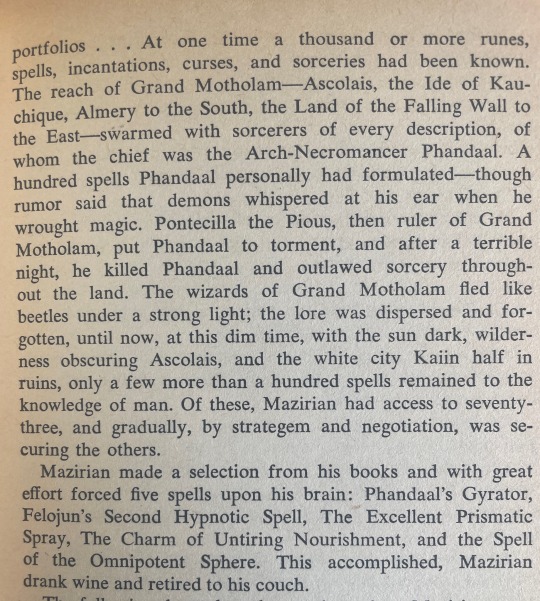
Vancian magic is cool as shit, actually. Page from The Dying Earth by Jack Vance.
#science fiction#fantasy#scififantasy#ttrpg#d&d#dungeons & dragons#osr#dnd#scifi#appendix n#jack vance
13 notes
·
View notes
Text
Rosevile Beach Reads Octavia Butler
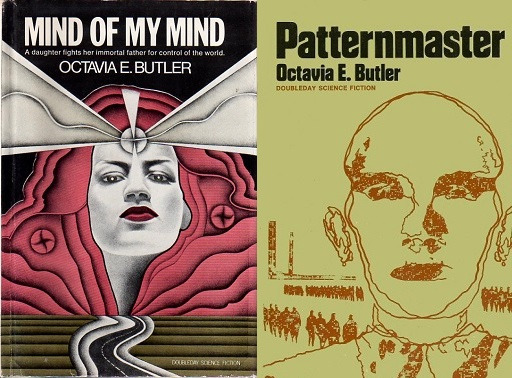
So on r-rook.studio, I’ve been building an Appendix N for Moonlight on Roseville Beach by looking at what genre paperbacks might show up in the town’s Paperback Exchange in 1979.
This time, I'm looking at Octavia Butler's exploration of a psionically powered far future that has its roots in very personal stories of people blessed and cursed by psi phenomena in the 20th century: The Patternist Series.
#octavia butler#books#patternist#patternmaster#tabletop gaymes#ttrpgs#tabeltop rpgs#tabletop roleplaying#roseville beach reads#moonlight on roseville beach#appendix n
8 notes
·
View notes
Text
I gave my players an "appendix N" for our upcoming campaign of Heart: the City Beneath. If you've got suggestions to add to the list, shout them out!
“Heart of Darkness” — novel by Joseph Conrad
“Apocalypse Now” — film directed by Francis Ford Coppola
“Annihilation” — novel by Jeff VanderMeer (as well as the sequels “Authority” and “Acceptance”)
“Roadside Picnic” — novel by Boris & Arkady Strugatsky
“Stalker” — film directed by Andrei Tarkovsky
“After a City is Buried” — video essay by Jacob Geller*
“The Shape of Infinity” — video essay by Jacob Geller*
“Carceri d'invenzione” (“Imaginary Prisons”) — series of etching illustrations by Giovanni Battista Piranesi
“The Silt Verses” — podcast created by Jon Ware and Muna Hussen
“Control” — game by Remedy Entertainment
“Fallen London” — game by Failbetter Games
“Hellboy II: The Golden Army” — film directed by Guillermo del Toro
“Crumbling Castle” — song by King Gizzard & the Lizard Wizard (album “Polygondwanaland”, 2017)
“The Terror” — AMC miniseries, season 1
“WTF 101”, episode “History’s Most Doomed Expeditions” — webseries by Dropout.TV
(* really just about every video essay by Jacob Geller could be on here, but I’ll limit it to just these few)
Is the last item on the list a little too foreboding? Too on-the nose?
The book does have its own appendix of suggested media, and a few items from that made it on here, but I wanted something more personalized and specific to me and my group.
And yes, I put both "Heart of Darkness" and "Apocalypse Now", and Roadside Picnic" and "Stalker" on the list. I feel like in both cases there are enough differences from the book to the movie that both are relevant to my list.
5 notes
·
View notes
Text
Some thoughts on Fafhrd and the Grey Mouser after finishing the first 3 volumes:
Before I go on, would I recommend FnGM: Yes but don't read every story. I have completionist brain when it comes to media, do not be like me, read the ones everyone recommends. A short list would be Ill Met in Lankhmar, Jewels in the Forest, Thieves' House, Bazaar of the Bizarre, Lean Times in Lankhmar, and Stardock. If I do a reread, it'll look a little like that.
FnGM makes a really bad first impression. The Snow Women, and frankly a lot of FnGM stories, are unusually misogynistic even for their time period. The Snow Women has parts I would generally recommend, but I can't, because they're enmeshed with the most intense hate wife bullshit that it shunts me out of the narrative constantly. This is a repeated problem in the stories, with not infrequent rape threats, treating women extremely badly, and just being generally fucking awful? I know FnGM are supposed to be bad people but this is literally everyone in every story all the time. If you're doing a FnGM read, I would recommend skipping The Snow Women, Claws from the Night, Their Mistress The Sea, and the last two books entirely. Those are the worst offenders.
Instead of that, you should start with Ill Met At Lankhmar, which is the first story in the collection order that is both well written and not pointlessly offensive. It's a banger! And it sets the stage for what's so good about FnGM anyhow: two shitty rogues who are a little too witty, fucking up despite their competence. When FnGM shines, this is usually what it's doing. I don't even recommend swinging back to read the first stories later, although the ski fight at the end of Snow Women IS pretty cool.
Leiber's prose is as good as people say it is. I think it's a lot like Moorcock's prose where it's a little annoying by default, until it's ON, and then it's some truly stellar prose that you will remember for a LONG time, and then you fall in love with the default prose too.
Swords Against Death is easily the best single volume of FnGM. It contains the most iconic FnGM stories and it really shows the duo doing their best schtick in the best way. For my money, Jewel in the Forest is my favorite story. That probably says something about me (that I'm really into weird, mindbending, abstract big reveals and care very little about swordplay).
People sleep on The Cloud of Hate. It rocks. It's helped by its short page count, it could've easily gone on past its worth. It doesn't, so the metaphor lasts JUST long enough to feel really cool. Absolutely no idea how you'd use it in a TTRPG, despite my reflex to do so.
Lean Times in Lankhmar feels like a Pratchett novel built for me. I don't really like Pratchett? It always feels like he's taking an extremely long time to say anything and then when he finally says what he wants to say, it's an anticlimax, and the joke doesn't land for me? Anyway, LTiL's pagecount is brief enough that it doesn't do that. If every Pratchett book was like this, I'd be a big Pratchett fan.
I genuinely can't get over Their Mistress The Sea. It's only 5 pages but it has the single most grotesque line in the first three books, which is to the effect of "maybe the witches are mad they weren't raped?" Between this and the pedophilic predilection of Mouser in the later stories, one wonders about Leiber. He says Fafhrd is based on him and Mouser is based on a friend and MAN that is an awful thing to say about someone. I also, disagree, from what i know of the man he was more like Mouser. So.
On the whole, a neat series. Deserves classic status. I need to say "do not read them all, do not read them in order" again, because you really really shouldnt do that. I think I narrowly prefer Elric? I think I'd prefer FnGM in the "Leiber respects women" timeline.
2 notes
·
View notes
Text
Got my core rule book for Dungeon Crawl Classics in the other day! The magic system in this game is wild!
Id urge everyone to give the game a shot, goodman games does free demos on Tuesdays, and That's what got me hooked!
You can also get the quick start rules for free!
The art is beautiful,the rules are simple yet engaging and watching your 0 level peasant evolve into a legend is amazing!
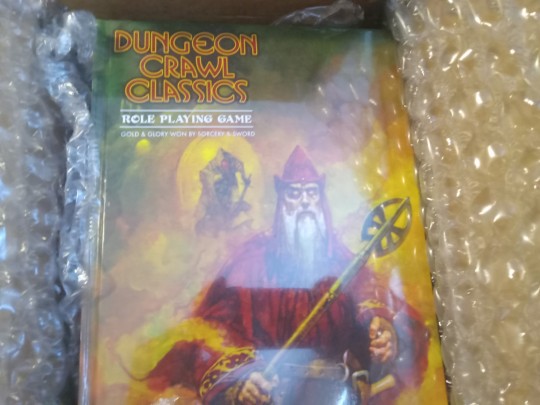
3 notes
·
View notes
Photo
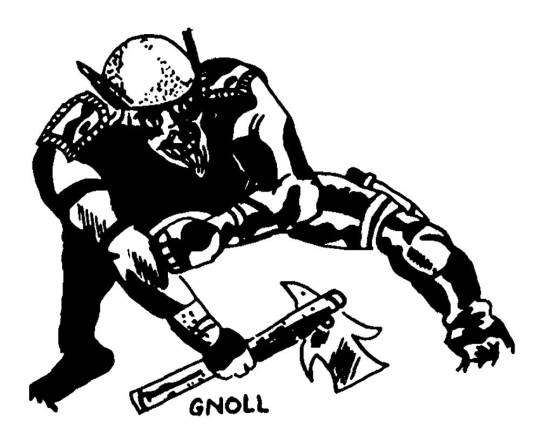
“Gnolls: A cross between Gnomes and Trolls (. . . perhaps, Lord Sunsany (sic) did not really make it all that clear) with +2 morale. Otherwise they are similar to Hobgoblins, although the Gnoll king and his bodyguard of from 1-4 will fight as Trolls but lack regenerative power.” (Dungeons & Dragons, Volume 2: Monsters & Treasure, Tactical Studies Rules, 1974; Greg Bell illustration)
As he noted, Gary Gygax borrowed the name “gnole” from a story by the Anglo-Irish writer Lord Dunsany. The “cross between Gnomes and Trolls” detail was entirely a product of Gygax’s imagination, based solely on the appearance of his spelling of the name. When he rewrote the monster descriptions for AD&D he kept the name but gave them a new identity as hyena-men.
Lord Dunsany’s “How Nuth Would Have Practised His Art upon the Gnoles” first appeared in The Book of Wonder in 1912. He did not describe his gnoles beyond being a very dangerous sort of woodland creature that kept large emeralds. An illustration showed shadowy ape-like shapes.
Margaret St. Clair wrote more about Dunsany’s gnoles in her story “The Man Who Sold Rope to the Gnoles,” in The Magazine of Fantasy and Science Fiction, V2 N5, October 1951, under the pseudonym Idris Seabright. She described gnoles as lumpy (”a little like a Jerusalem artichoke made of India rubber”) and with tentacles, repeating Dunsany’s details about having emeralds in their homes and their habit of hiding in holes in tree trunks. Gygax acknowledged both St. Clair and Lord Dunsany as inspirations in Appendix N of the AD&D Dungeon Masters Guide.
#OD&D#gnoll#Appendix N#D&D#dnd#Gary Gygax#gaming history#Lord Dunsany#Dungeons & Dragons#Margaret St Clair#gnoles#gnole#Idris Seabright#How Nuth Would Have Practiced His Art upon the Gnoles#The Book of Wonder#Dungeons and Dragons#1970s
156 notes
·
View notes
Text


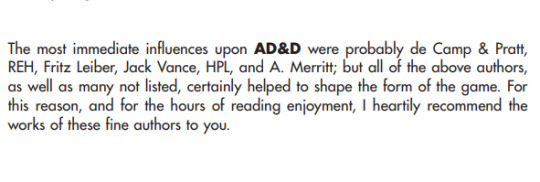
The famous Appendix N (it literally has books written about it) from the AD&D 1E Dungeon Masters guide. Even a quick perusal reveals D&D's inspiration comes from a much wider range of sources than one might assume. How many have you read… on THAC0 Thursday!!
#thac0#thaco#thac0 thursday#thaco thursday#dungeons & dragons#d&d#ad&d#dnd#rpg#ttrpg#books#appendix n
0 notes
Text

Funny thing: I’m not really a big fan of fantasy fiction. I’ve always liked Leiber, and I appreciate a fair amount of Howard and Moorcock, and I was really into Tolkien for a spell, but for the majority of my life, I mostly enjoyed fantasy in the context of RPGs. I’ve read far, far more horror fiction. In recent years, I’ve been trying to read more science fiction and fantasy. I find sci-fi easier, honestly, especially since I find the modern fantasy genre’s obsession with world-building and complex magic systems tedious in the extreme. It was not always so! As Appendix N, edited by Peter Bebergal, illustrates, fantasy can be short, zippy and still work when it implies a world instead of painstakingly detailing one.
The idea here is to present a taste of the fiction from Gygax’s Appendix N in the Dungeon Masters Guide. Gygax mostly recommends novels, which is a bit of a complication for an anthology of short fiction. Gygax’s list is also not entirely sensical, too. Why on earth did he only list volume three of Swords Against Darkness? Why did he mention Lin Carter’s World’s End books and not the Thongor books, or just the third volume of Fred Saberhagen’s Empires of the East series? And no Clark Ashton Smith at all? Bebergal addresses these odd oversights with his selections — my favorite in this regard is the reprinting of Frank Brunner’s “Sword of Dragonis,” a gorgeous 1971 comic story. Gygax cops to being influenced by comics, but doesn’t get into specifics, so Bebergal shows us something from the period that could have been on Gygax’s mind.
It’s a fantastic, clarifying anthology. Perhaps less useful for finding the secret source of D&D and more for getting a full and varied look at the fantasy of that moment. It should be on your shelf, probably. And I hope we get a volume two.
#RPG#TTRPG#Tabletop RPG#roleplaying game#Novel#Appendix N#Strange Attractor#Peter Bebergal#D&D#Dungeons & Dragons
107 notes
·
View notes
Note
u should draw dave and karkat trying the grimace shake Cuz for some reason i dreamt that u did while i was having surgery LOL

they hate us cus they anus
#asks#requests#I LOVE U GIRL IM SO GLAD UR SURGARY WENT WEL ILYYYYY#fuck tha stupid appendix !!!!!!!!!!! RAAGHHGRAAAAAAAAAAA#thats amazing LMAO i had 2 be put under for surgery n had no dreams at all ... waow/... the power of our love#strongar than any sedatives!!!
49 notes
·
View notes
Text
Got a great haul from a bookstore in the desert last weekend.
That Dying Earth cover 🤩
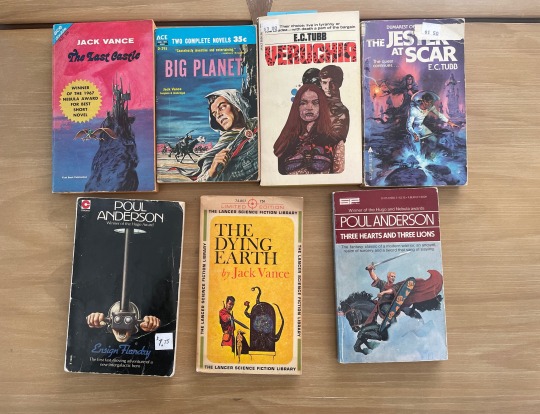
10 notes
·
View notes
Text
August Roseville Beach Reads
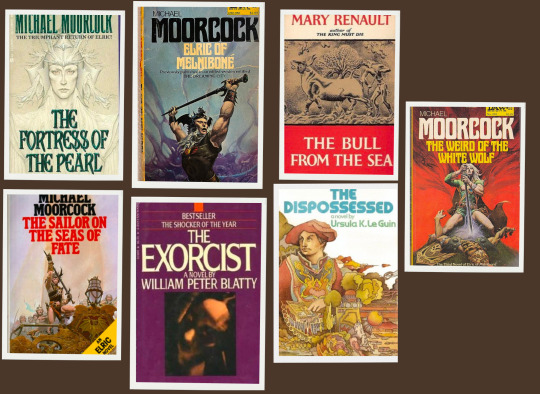
So I felt pretty unproductive in August. I went into a second bout with Elric hoping I'd like him better than I did the first time I tried to read him, but that wasn't really the case. I certainly appreciate him better than I did, but getting through those books was a fucking slog, and I'm happy to be done. Technically, the Fortress of the Pearl isn't a Roseville Beach Read since it came out in 1989, and technically I strongly prefer to read series in publication order, but I was stuck with an omnibus edition so I ground my teeth and got through it. (Some would say the same thing for Weird of the White Wolf, but it's all reprints/rewrites of shorter fiction that was published in the 60s.)
I'd been meaning to pick up both The Exorcist and The Bull from the Sea for years decades and kept not getting around to it. If I'm ever stuck in a 70s paperback exchange, I'd happily read either one again.
The Dispossessed, which I hadn't read before, is probably the best, most rewarding book I've read this summer. Getting through it while dealing with some of my own inner demons was rough, but I can't recommend it highly enough.
#no more moorcock#elric of melnibone#weird of the white wolf#fortress of the pearl#sailor on the seas of fate#the dispossessed#the bull from the sea#the excorcist#moonlight on roseville beach#roseville beach reads#tabletop gaymes#tabletop rpgs#appendix n
6 notes
·
View notes